25/03/21 - Beautiful and impossible, the Yamaha Trial 4-stroke born to counter the rival Honda
It is seen in Europe only for the Trial of Nations because Kenichi Kuroyama rides it, one of the three evergreen Japanese riders, sensationally vice-champions of the 2019 world.
The unexpected runner place was conquered at the Trial of Nations held in Ibiza in September 2019. In addition to Kuroyama, the trio could count on Takahisa Fujinami, number three in the 2019 world ranking, and Tomoyuchi Ogawa. With Fujigas more Catalan than Japanese - since he has lived in this region of Spain for more than twenty years and often participates in the Spanish championship - the fight for the title of the Land of the Rising Sun has remained a bargain for the two "youngsters" of the last twenty years: 45-year-old Ogawa and two-year-old younger Kuroyama. The first has always been the standard bearer of Honda and the second necessarily the opposite, riding a very special Yamaha. The couple boasts the en-plein of titles since Fujinami no longer races in his native country: nine for Ogawa and twelve for Kuroyama.
A reality that shows, once more, that even in Japan there is a crisis of young people at the top. After all, a sport that requires long sacrifices and long waits before obtaining prestigious results, is not tempting to the new generations, ready to abandon along the way. In fact, behind the two over forties, there is another "young" of 38 years, Fumitaka Nozaki, who has been entrusted with another "special" Yamaha: one of the three produced. The third ended up in the hands of a real young man, 21-year-old Koji Hisaoka.
Among these three riders, the one who boasts the longest stay in Yamaha is Nozaki. Together with Isao Shibuya he participated in the whole world championship from 2002 to 2005, when it was Scorpa, a French company, that assembled the Yamaha engines and managed a respectable racing team, with an imposing structure that also provided assistance to minor races. In those years Kuroyama was often on the podiums in world trials, but he was riding for Beta. It was when he left the Circus to devote himself only to national competitions that he landed in Yamaha. It was 2006, and since then he has only competed in the two rounds of Motegi or - when Japan was present - in the Trial of Nations.
The first 4-stroke that Kuroyama and Nozaki brought to competitions in 2007 was the one produced and sold by Scorpa until 2010. The displacement was 250 cm3. It caused a sensation for that huge cylinder, derived from the cross model, which was adapted with difficulty to the slender Trial frame.
With the cessation of production of that model by the French company, Yamaha continued to keep updated only the two official bikes destined to Kuroyama and Nozaki. The displacement rose to almost 300 cm3 , but to keep up with number one rival, that was Honda - the only one to insist on the 4-stroke - was still necessary to improve the fuelling, replacing the carburettor power supply with the direct injection one.
The solution came in 2016 when an engine of the motocross model, the YZ 250 F, was once again adapted and using a modified frame from the Scorpa Twenty, a completely new bike was born. First only two units were assembled, which later became three, with the plan to test it in the world championship with the new Hisaoka lever. Unfortunately, Pietramurata's debut at the end of the 2018 season was not the best for the young Japanese.
We do not know if this was the reason for a revision of the plans.
All we know about the bike is due to the choice to converge in Italy in the last three years, to organize the logistics of the Trial of Nations. The ancient knowledge of the SRG company of Cantù, once a Scorpa importer, and the proven organizational structure of the La Croce Team of Villar Perosa (TO), which has been present for years on the Italian and European Motocross fields, have influenced the choice of Yamaha and have allowed an interesting approach to us.
Also in September 2019, in the week that preceded the highest team competition in the sector, held on the island of Ibiza, Kuroyama's bike was reassembled in our country. Also on this occasion rigorously without the control unit, which travelled as hand luggage together with the pilot.
As an old joke:"We trust you but ...". The Iwata Factory's message is that no one can try or test it. Then the bike on the truck with Fausto La Croce driving it left again towards Barcelona,from where was embarked for the island.
Although there is no official technical data, the friendship that was created between Fausto's son, Matteo and the Director of the Racing Department, the engineer Haruo Kimura, the first Japanese national champion in the 70s and famous for being the designer of all the recent engines, also used by Scorpa, have allowed us to obtain some data.
The engine is the 4-stroke derived from the same model that is popular in the motocross, the YZ 250 F. The displacement is almost 300cc thanks to an increase in the bore. The cylinder mounted in the vertical position is “reverse”: the intake and exhaust ports are interchanged.
This is to make better use of the injection feed, with the fuel falling from the small tank at the tip of the perimeter frame. From the internal part of the cylinder the exhaust pipe starts with a large curve in order to obtain greater torque, always useful in Trials. The frame is derived from the Scorpa model "twenty" but with modifications to be able to adapt a much larger engine. The swingarm is also different. Both the forks and the mono shock absorber are Tech. The weight should be around 77 kg.
It may seem absurd that a motorcycle born 4 years ago continues to be updated only in three prototypes and they do not think about producing it in series. But if you get into the mentality of the leaders of the Rising Sun, it can have a meaning. The Honda-Yamaha war is fought on the MotoGP, Motocross and Motorally racing fields, so Trials cannot be outdone. Most likely, at the top of Yamaha it emerged that the numbers in this market are always too low to justify putting it into production, knowing that the assembly costs would imply a perhaps uncompetitive selling price. It's a shame, because the strange world of this sport, in order to secure a rare piece, has always been willing to spend a few euros more ...
photos by shizenyama.com
---------------------------------------------------------------------------------------
Bella e impossibile la Yamaha 4 tempi da Trial nata per contrastare la rivale Honda
La si vede in Europa solo per il Trial delle Nazioni perchè la cavalca Kenichi Kuroyama, uno dei tre sempreverdi piloti giapponesi, clamorosamente vice-campioni del mondo 2019.
L'inaspettata piazza d'onore è stata conquistata al Trial delle Nazioni disputato a Ibiza a Settembre 2019. Il trio oltre a Kuroyama ha potuto contare su Takahisa Fujinami, numero tre nel ranking mondiale, e Tomoyuchi Ogawa . Con Fujigas più catalano che nipponico - visto che ormai da più di vent'anni dimora in questa regione della Spagna e spesso partecipa al campionato spagnolo - la lotta al titolo del Paese del Sol Levante è rimasta nel medesimo ventennio un affare per i due “giovincelli”: Ogawa 45-enne e Kuroyama più giovane di due anni. Il primo da sempre alfiere della Honda e il secondo obbligatoriamente all'opposto, in sella a una Yamaha tutta speciale. La coppia vanta l'en-plein dei titoli da quando Fujinami non corre più nel Paese natale: nove per Ogawa e dodici per Kuroyama.
Una realtà che evidenzia, una volta in più, che anche in Giappone c'è una crisi di giovani ai vertici. Del resto uno sport che richiede lunghi sacrifici e lunghe attese prima di ottenere risultati di prestigio, non fa gola alle nuove generazioni, pronte ad abbandonare strada facendo. Infatti dietro ai due ultra quarantenni, c'è un altro “giovane” di 37 anni, Fumitaka Nozaki, al quale è stata affidata un'altra Yamaha “speciale”: una delle tre prodotte. La terza è finita nelle mani di un vero giovane, il ventunenne Koji Hisaoka.
Dei tre cavalieri di questi prototipi, quello che vanta la più lunga permanenza nella Casa del diapason, è Nozaki. Insieme a Isao Shibuya partecipò a tutto il mondiale dal 2002 al 2005, quando era la Scorpa, azienda francese, a montare i motori Yamaha e gestire una squadra corse di tutto rispetto, con un imponente struttura che forniva assistenza anche alle gare minori. In quegli anni Kuroyama era sovente sui podi nelle prove iridate, ma difendeva i colori della Beta. Fu quando abbandonò il Circus per dedicarsi solo alle gare nazionali che approdò In Yamaha. Era il 2006, e da allora prese soltanto più parte ai due giorni di Motegi o – quando il Giappone era presente - al Trial delle Nazioni.
Il primo 4 tempi che Kuroyama e Nozaki portarono in gara nel 2007 fu quello prodotto e venduto dalla Scorpa fino al 2010. La cilindrata era di 250 cm3. Fece scalpore per quel cilindro enorme, di derivazione dal modello da cross, che con fatica si adattava al telaio esile di un Trial.
Con la cessata produzione di quel modello da parte dell'azienda d'oltralpe, la Yamaha continuò a mantenere aggiornate soltanto le due moto ufficiali destinate a Kuroyama e Nozaki. La cilindrata salì a quasi 300 cm3 e si tentò di rimanere al passo della concorrenza, ma il grosso limite nel confronto con la rivale Honda unica a insistere con il 4 tempi, rimase l'alimentazione a carburatore rispetto a quella a iniezione diretta.
La soluzione giunse nel 2016 quando ancora una volta venne adattato un motore del modello da cross, l' YZ 250 F e utilizzando un telaio modificato della Scorpa Twenty, nacque una moto completamente nuova. Prima vennero assemblati soltanto due esemplari, diventati in seguito tre, con il progetto di testarla nel mondiale proprio con la nuova leva Hisaoka. Purtroppo l'esordio alla prova di Pietramurata a fine stagione 2018 non fu dei migliori per il giovane giapponese. Cadde alla prima zona e dovette ritirarsi per aver rimediato una brutta botta al bacino.
Non ci è dato sapere se questo fu il motivo di una revisione dei piani: o giapponesi sono sempre molto ermetici nel rivelare notizie.
Tutto quello che sappiamo sulla moto è grazie alla scelta di convergere in Italia negli ultimi tre anni, per organizzare la logistica del Trial delle Nazioni. Le antiche conoscenze della società SRG di Cantù, un tempo importatrice Scorpa, e la collaudata struttura organizzativa del Team La Croce di Villar Perosa (TO), da anni presente sui campi di Motocross italiani ed europei, hanno influenzato la scelta di Yamaha e hanno permesso a noi un interessante avvicinamento.
Anche a Settembre di due anni fa, nella settimana che ha preceduto la massima competizione a squadre del settore, disputata sull'isola di Ibiza, la moto di Kuroyama è stata rimontata nel nostro Paese, Anche in questa occasione rigorosamente sprovvista della centralina, che ha viaggiato come bagaglio a mano insieme al pilota. Della serie “Fidarsi è bene ma ...” . Il messaggio della Casa di Iwata è che nessuno la può provare o testare. La moto è poi ripartita sul camion con alla guida Fausto La Croce alla volta di Barcellona, da dove si è imbarcato per l'isola. Pur non essendoci dei dati ufficiali tecnici, l'amicizia che si è creata fra il figlio di Fausto, Matteo e il Direttore Reparto Corse, l'ingegnere Haruo Kimura, primo campione nazionale giapponese negli anni 70 e famoso per essere stato il progettista di tutti i recenti motori, usati anche dalla Scorpa, ci hanno permesso di ricavare qualche dato.
Il motore è il 4 tempi derivato dal medesimo modello che spopola nel cross, la YZ 250 F. La cilindrata è di quasi 300cc grazie ad una maggiorazione dell'alesaggio. Il cilindro montato in posizione verticale è “inverso”: luce di alimentazione e scarico sono scambiate. Questo per sfruttare meglio l'alimentazione ad iniezione, con la caduta della benzina dal piccolo serbatoio in punta al telaio perimetrale. Dalla parte interna del cilindro parte il tubo di scarico con una grande curva che serve a garantire una maggiore coppia, sempre utile nel Trial. Il telaio è derivato dalla Scorpa modello “twenty” ma con modifiche per poterci adattare un motore decisamente più grande. Il forcellone è anche differente. Sia le forcelle come il mono ammortizzatore sono Tech. Il peso dovrebbe essere intorno ai 77 kg.
Può sembrare assurdo, per come siamo abituati a ragionare noi, che una moto nata 4 anni fa, continui a venire aggiornata solo in tre esemplari e non si pensi a produrla in serie. Ma se si entra nella mentalità dei dirigenti del Sol Levante, la cosa può avere un significato. La guerra Honda-Yamaha si combatte sui campi di gara della MotoGP, del Motocross, del Motorally, dunque il Trial non può essere da meno. Molto probabilmente ai vertici Yamaha è emerso che i numeri di questo mercato sono sempre troppo bassi per giustificarne una messa in produzione, sapendo che i costi di assemblaggio implicherebbero un prezzo di vendita forse non competitivo. E' un peccato, perchè lo strano mondo di questo sport, pur di assicurarsi un pezzo raro, è sempre stato disposto a spendere qualche euro in più...
---------------------------------------------------------------------------------------
------------------------------------------------------------------------------------------
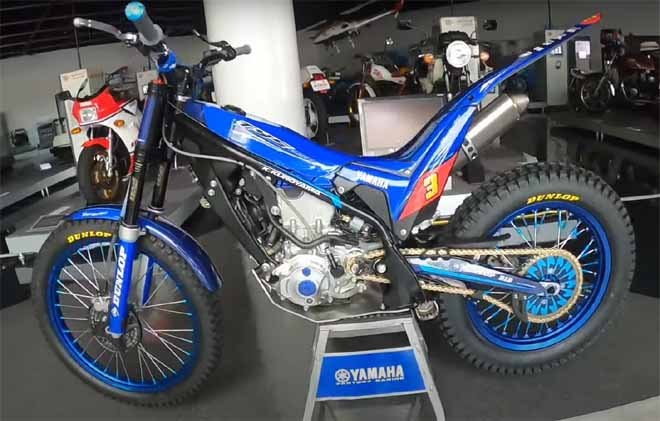 2021 model
2021 model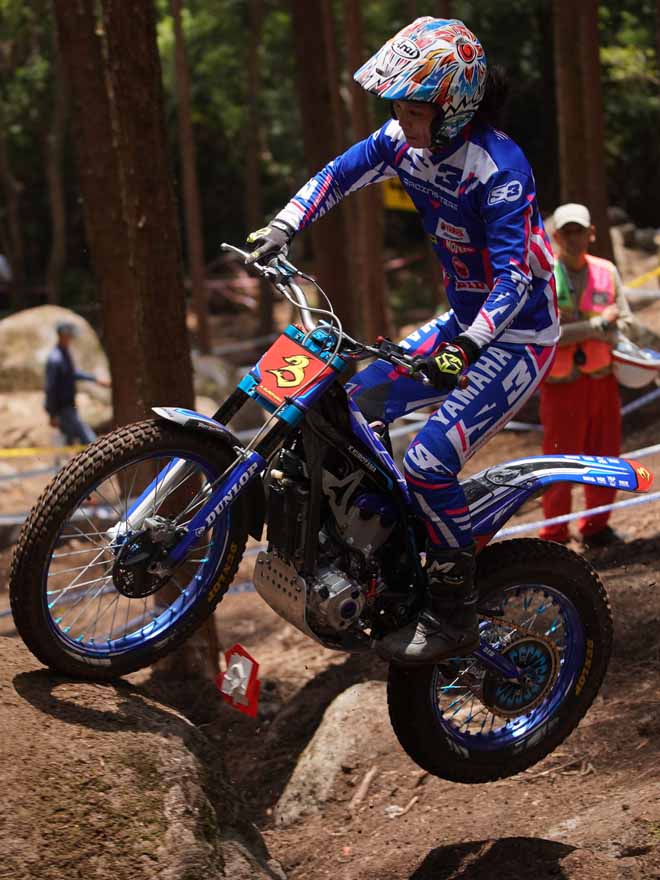 Kenichi Kuroyama
Kenichi Kuroyama 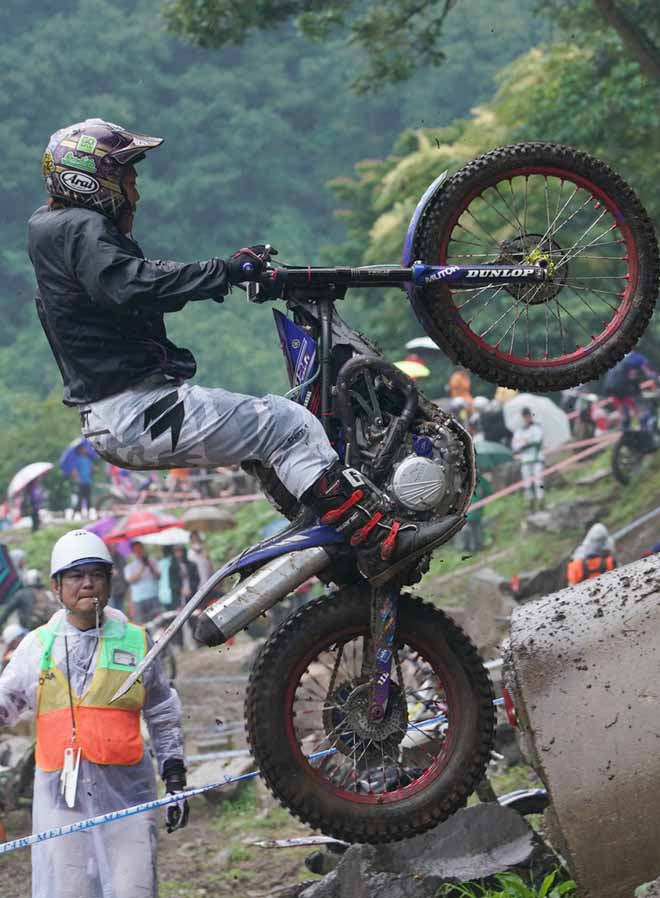 Fumitaka Nozaki
Fumitaka Nozaki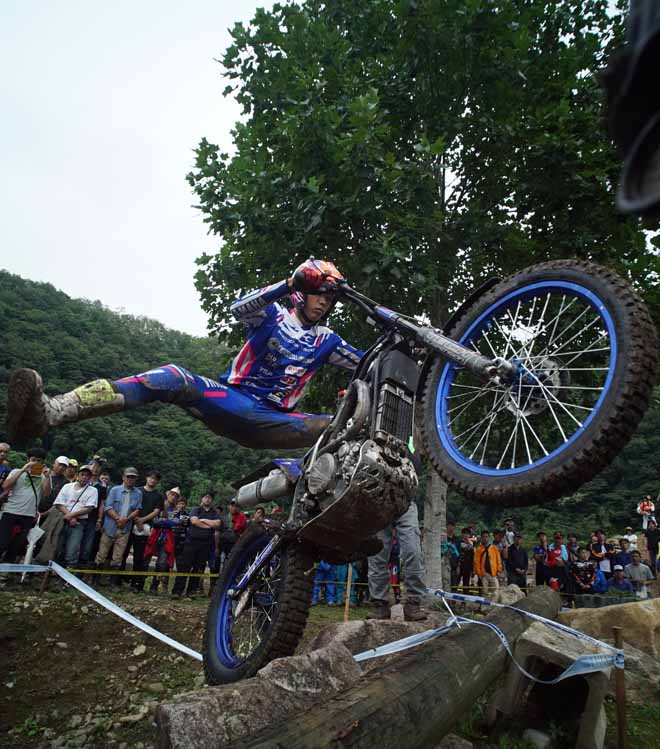 Koji Hisaoka
Koji Hisaoka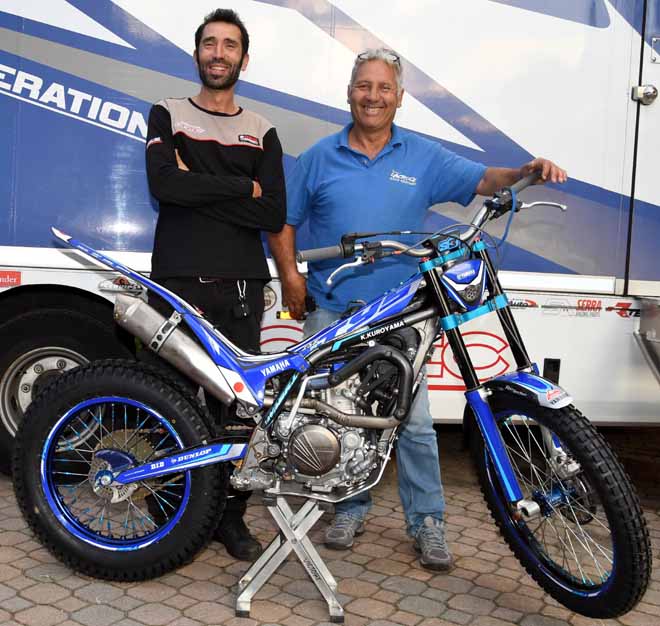 Matteo e Fausto La Croce
Matteo e Fausto La Croce---------------------------------------------------------------------------------------

